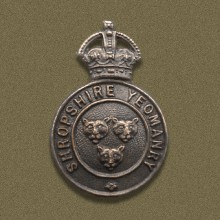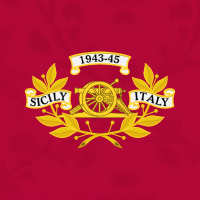1/1st Shropshire Yeomanry
The 1/1st Shropshire Yeomanry was mobilised with the Welsh Border Mounted Brigade on 4 August 1914 at the outbreak of the First World War. It moved to East Anglia where it joined the 1st Mounted Division in September 1914. [9] In November 1915, the brigade was dismounted. [10]
The regiment was posted with the brigade to Egypt in March 1916. On 20 March, Welsh Border Mounted Brigade was absorbed into the 4th Dismounted Brigade (along with the South Wales Mounted Brigade). [11]
The brigade was with the Suez Canal Defences when, on 14 January 1917, Egyptian Expeditionary Force (EEF) Order No. 26 instructed that the 2nd, 3rd and 4th Dismounted Brigades be reorganized as the 229th, 230th and 231st Brigades. [12]
Between January and March 1917, the small Yeomanry regiments were amalgamated and numbered as battalions of infantry regiments recruiting from the same districts. [a] As a result, the 1/1st Shropshire Yeomanry was amalgamated with the 1/1st Cheshire Yeomanry at Cairo on 2 March 1917 to form the 10th (Shropshire and Cheshire Yeomanry) Battalion, King's Shropshire Light Infantry (10th KSLI). [14] [15] [16]
On 23 February, the General Officer Commanding the EEF, Lieutenant-General Sir A.J. Murray, sought permission from the War Office to form the 229th, 230th and 231st Brigades into a new division. On 25 February, the War Office granted permission and the new 74th (Yeomanry) Division started to form. The 231st Brigade joined the division at el Arish by 9 March. [12] The 10th KSLI remained with 231st Brigade in 74th (Yeomanry) Division for the rest of the war. [13]
It took part in the invasion of Palestine in 1917 and 1918, including the Second (17–19 April 1917) and Third Battles of Gaza (27 October–7 November) –including the capture of Beersheba on 31 October and the Sheria Position on 6 November. At the end of 1917, it took part in the capture and defence of Jerusalem and in March 1918 in the Battle of Tell 'Asur. On 3 April 1918, the division was warned that it would move to France and by 30 April 1918 had completed embarkation at Alexandria. [12]
In May 1918, the battalion landed at Marseille, France with 74th (Yeomanry) Division. It served in France and Flanders with the division for the rest of the war. By 18 May, the division had concentrated around Rue in the Abbeville area. Here the dismounted Yeomanry underwent training for service on the Western Front, particularly trench warfare and gas defence. [17]
On 14 July 1918. the Yeomanry Division went into the line for the first time, near Merville on the right of XI Corps. From September 1918, as part of III Corps of Fourth Army, it took part in the Hundred Days Offensive including the Second Battle of the Somme (Second Battle of Bapaume) and the Battles of the Hindenburg Line (Battle of Épehy). In October and November 1918, it took part in the Final Advance in Artois and Flanders. By the Armistice, it was near Tournai, Belgium, still with 74th (Yeomanry) Division. [17]
With the end of the war, the troops of 74th Division were engaged in railway repair work and education was undertaken while demobilisation began. The division and its subformations were disbanded on 10 July 1919. [17]
2/1st Shropshire Yeomanry
The 2nd Line regiment was formed in 1914 and joined the 2/1st Welsh Border Mounted Brigade in the Newcastle area of Northumberland in January 1915 [18] (along with the 2/1st Cheshire Yeomanry and the 2/1st Denbighshire Hussars). [19] The brigade was placed under the command of the 63rd (2nd Northumbrian) Division. [20] On 31 March 1916, the remaining Mounted Brigades were ordered to be numbered in a single sequence and the brigade became 17th Mounted Brigade, still in Northumberland under Northern Command. [11]
In April 1916, it moved with its brigade to East Anglia where it joined the 1st Mounted Division; it replaced its 1st Line, which had departed (dismounted) for Egypt. [10] By July, it had left with its brigade for the Morpeth, Northumberland area. [18]
In July 1916, there was a major reorganization of 2nd Line yeomanry units in the United Kingdom. All but 12 regiments were converted to cyclists [11] and as a consequence the regiment was dismounted and the brigade converted to 10th Cyclist Brigade. Further reorganization in October and November 1916 saw the brigade redesignated as 6th Cyclist Brigade in November, still in the Morpeth area. [21] In March 1917, the regiment moved to Newbiggin, and later to Woodhorn near Morpeth. [18]
Early in 1918, the Brigade moved to Ireland and was stationed at The Curragh. [21] There were no further changes before the end of the war. [22] [14]



